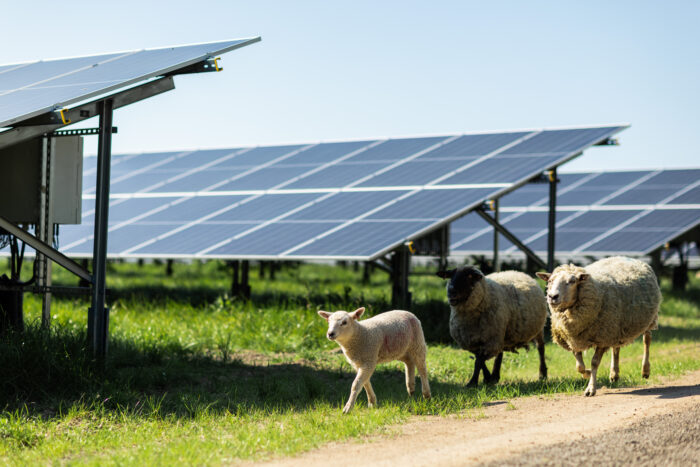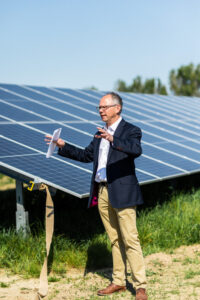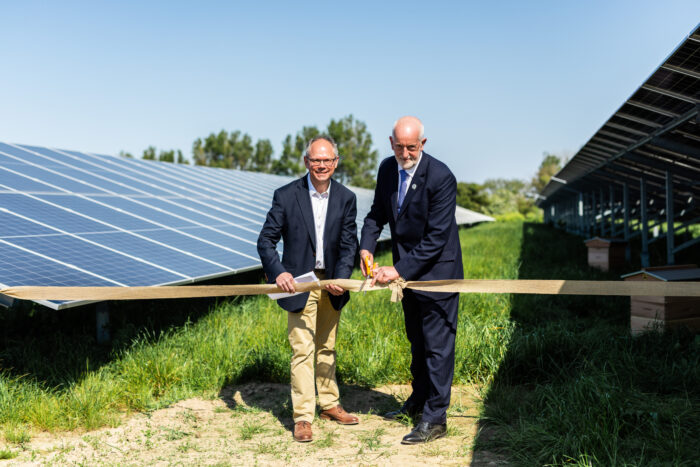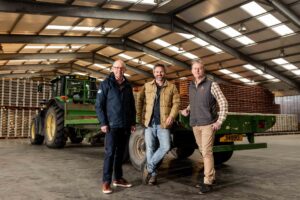
The opening of the new solar panel site in Rue du Moulin à Vent, St Clement, took place on 30 April.
The chief executive of the Jersey Electricity Company, Chris Ambler, was present, together with Steve Luce, Minister for Planning and Environment.
The following is taken from Mr Ambler’s speech:

‘Today marks a significant moment for Jersey and a key milestone towards a more secure energy future.
‘This facility is now fully operational, delivering local, home-grown renewable electricity directly into our homes and businesses.
‘While modest in size by international standards, this 4.3MW solar project represents a meaningful step forward— underscoring our Island’s collective commitment to sustainability, energy independence and community-driven progress.
‘It’s a major collaboration owned by the people, through the Government of Jersey’s interest in Jersey Electricty, for the people.
It’s a locally-owned, community-based project that reflects the values at the heart of our Island.
The project aligns wholly with several Government policies, including the Island Plan, the Carbon Neutral Roadmap, and the Rural Economy Strategy.
And the benefits are clear. This installation alone will generate enough electricity to power 14% of homes in St Clement—around 650 fully electric households— for the next four decades.
‘Our broader solar strategy is ambitious but achievable.
‘Within the next two years, we aim to build 25MW of solar capacity across the Island, capable of securely meeting around one-third of Jersey’s peak summer demand.
‘With the drama of major power cuts in Spain and Portugal, we’ve seen very clearly this week just how dependent we are on electricity supplies.
‘Projects like these provide alternative sources of energy and build diversity.
‘But this isn’t just about diversity, it’s about holding energy costs down and protecting consumers with lower and more stable prices over the long term.
‘This project also goes well beyond energy. With the support of our partners sanctuary for biodiversity and wildlife – insects, birds, rodents, flora and fauna.
‘Furthermore, the land itself must remain in agricultural use – we ourselves insisted on this from the “go” – and it’s helping to diversify Jersey’s rural economy by supporting more sustainable, innovative farming practices – the so-called “agrivoltaics”.
‘Today, we can see agrivoltaics in action.
‘Jeremy Hughes of Panigot Farm, our solar shepherd partner, has relocated his flock of sheep back to the site.
‘These lambs will help manage the land while producing high-quality, locally-reared lamb for Jersey’s restaurants.
‘We’re proud to support nascent farming businesses, like Jeremy’s, and support diversification that is now so vital to a struggling farming sector.
‘Over the next 40 years, this land will enjoy a break from intensive farming, allowing the soil to recover and enrich, helping water retention and sequestering carbon from the atmosphere.
‘This is how we deliver a just transition—keeping energy affordable for all whilst at the same time creating opportunities for future generations, protecting the land and our environment, and supporting livelihoods – all at the same time.
‘This project shows what we can achieve when we work together.
‘Over 30 local suppliers contributed to its success as well as UK experts sharing and ultimately transferring their industry know-how and experience into the local supply base.
We were keen that this project be of high quality – and I think you will see this clearly today.
‘Projects like this keep money in the local economy and stimulate our construction sector, and they equip our workforce with valuable green skills needed to thrive in a low-carbon future.
‘We estimate around 35-40 people within JE have touched this project and been an important part of its success. Thank you to you all.
‘St Clement is setting a powerful example of how local communities can rise to the challenge of the energy transition—and directly benefit from the results.
Islanders will be able to see for themselves – updated every 15mins – how their solar facility is powering their lives, at any time of the day.
‘And it will be brought to life using meaningful comparisons; equivalent houses supplied, cups of tea made, miles of travel in an EV.
‘You might be interested to know that during testing and commissioning, for example, the solar farm has generated 482 MWh in March alone (around £30-40k worth of avoided imported power) – more than 30% ahead of forecast – enough energy to power 64 properties for a full year.
‘So, we’re putting information as well as local power, into the hands of Islanders.
‘We know that not everyone is supportive of these schemes. nd to them I would say this:
‘First, as consumers of energy we need to take some level of responsibility for producing it here in Jersey. Ground solar is pretty much the only way of doing this cleanly and cost effectively.
‘Secondly, these facilities are not displacing agriculture but supplementing it. We are targeting low grade land – but whatever land we use, it stays in agricultural use. We are pursuing six solar schemes in the delivery of our 25MW target which collectively represents just 0.6% of agricultural land. It’s worth noting that 27% of agricultural land lies unused today.
‘Thirdly, we are also working harder than ever on roof solar PV on commercial buildings and we are scaling up propositions for the residential market. So it’s not ground or roof solar – its ground and roof solar .. that is needed in the future energy system.
‘Finally, I hope the environmental benefits are clear from what I said earlier. Far from damaging the countryside, these schemes are here to improve it. But there is a fail-safe. If at the end of the 40-year life, the next generation want to do something different, all this kit will be automatically removed – and we can be sure that the earth will be left in a better condition than ever before.
‘Together, we are laying the foundations for a more resilient, self-sufficient, and sustainable Jersey.’






2 Responses
Dear Sir,
I would hope that the cleaning requirements for these panels has been worked out.
Furthermore, I’ve been told that these panels come from the UK, who no longer manufacture Solar Panels. So, it would appear that these are made in China, a country who predominantly run their factories using coal powered power stations.
Therefore, as it takes around 12 years to offset the carbon produced to create Chinese panels, maybe we should be investing in tidal power instead, if we truly want to play the environmental card.
How much extra will EDF charge JEC for providing a supply that follows our sunshine up and down ? The EDF generators and system will need to be on standby to cater for these changes. Historical supply companies make extra charges for this facillity and EDF could be rubbing its hands in glee at the prospect of the next round of tariff negotiations with Mr. Ambler. I trust this has been accounted for in his plans, but confirmation would be welcomed.